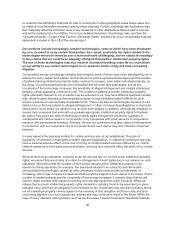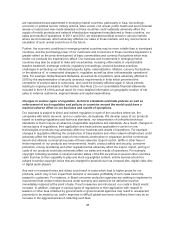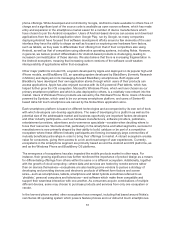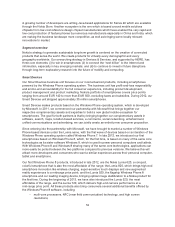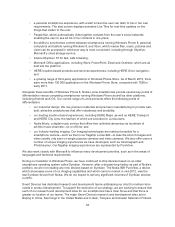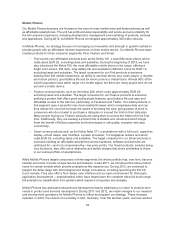Nokia 2012 Annual Report Download - page 46
Download and view the complete annual report
Please find page 46 of the 2012 Nokia annual report below. You can navigate through the pages in the report by either clicking on the pages listed below, or by using the keyword search tool below to find specific information within the annual report.Furthermore, in the normal course of business Nokia Siemens Networks enters into a large number of
accounts receivables sale agreements with banks and other financial institutions. If Nokia Siemens
Networks’ were not able to sell these accounts receivables in line with its past practice for whatever
reason, including, but not limited to, the actual or perceived deterioration of its customers’ credit
quality, banks’ refinancing abilities or prevailing interest rates, this could negatively impact our liquidity
and our ability to meet our working capital requirements.
Nokia Siemens Networks has historically received financial support in the form of additional capital
from its shareholders Nokia and Siemens. Nokia and Siemens do not, however, guarantee Nokia
Siemens Networks’ current financial obligations. There is no assurance that Nokia Siemens Networks
will receive similar or other financial support from its shareholders in the future.
Nokia Siemens Networks may be adversely affected by customer financing or extending
payment terms it provides to customers.
Communication service providers in some markets may require their suppliers, including Nokia
Siemens Networks, to arrange, facilitate or provide financing in order to obtain sales or business. They
may also require extended payment terms. In some cases, the amounts and duration of these
financings and trade credits, and the associated impact on Nokia Siemens Networks’ working capital,
may be significant. Credit markets in general have been tight since 2009. Requests for customer
financing and especially extended payment terms have remained at a reasonably high level. However,
during 2012, the amount of financing provided directly to our customers has decreased.
Uncertainty in the financial markets may result in more customer financing requests. As a strategic market
requirement, Nokia Siemens Networks primarily arranged and facilitated, and plans to continue to arrange
and facilitate, financing to a number of customers, typically supported by export credit or guarantee
agencies. In the event that those agencies face future constraints in their ability or willingness to provide
financing to our customers, it could have a material adverse effect on Nokia Siemens Networks business.
Nokia Siemens Networks has agreed to extended payment terms for a number of customers, and it will
continue to do so. Extended payment terms may continue to result in a material aggregate amount of trade
credits. Even when the associated risk is mitigated by the fact that the portfolio relates to a variety of
customers, defaults in the aggregate could have a material adverse effect on us.
Nokia Siemens Networks cannot guarantee that it will be successful in arranging, facilitating or
providing needed financing, including extended payment terms to customers, particularly in difficult
financial market conditions. In addition, certain of Nokia Siemens Networks’ competitors may have
greater access to credit financing, which could adversely affect its ability to compete successfully for
business in the networks infrastructure and, indirectly, in the related services sectors. Nokia Siemens
Networks’ ability to manage its total customer finance and trade credit exposure depends on a number
of factors, including its capital structure, market conditions affecting its customers, the level and terms
of credit available to Nokia Siemens Networks and to its customers, the cooperation of export credit or
guarantee agencies and its ability to mitigate exposure on acceptable terms. Nokia Siemens Networks
may not be successful in managing the challenges associated with the customer financing and trade
credit exposure that it may have from time to time. While defaults under financings, guarantees and
trade credits to Nokia Siemens Networks’ customers resulting in impairment charges and credit losses
have not been a significant factor for us, these may increase in the future, and commercial banks may
not continue to be able or willing to provide sufficiently long-term financing, even when backed by
export credit agency guarantees, due to their own liquidity constraints. See Item 5B. “Liquidity and
Capital Resources—Structured Finance,” and Note 34(b) to our consolidated financial statements
included in Item 18 of this annual report for a more detailed discussion of issues relating to customer
financing, trade credits and related commercial credit risk.
45



